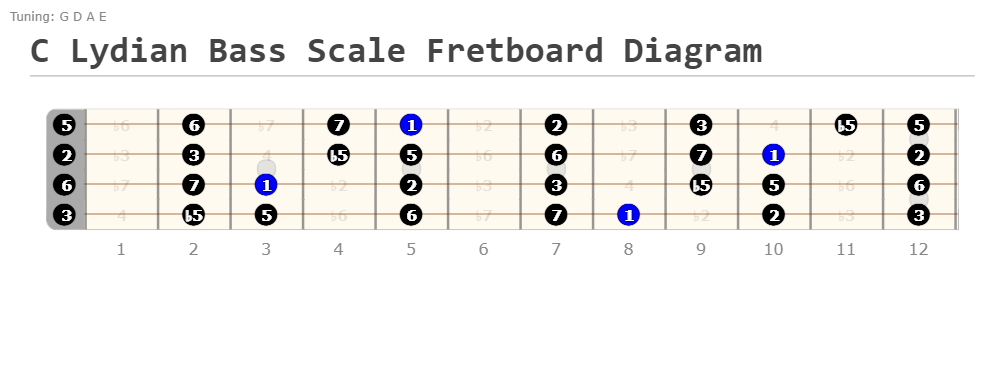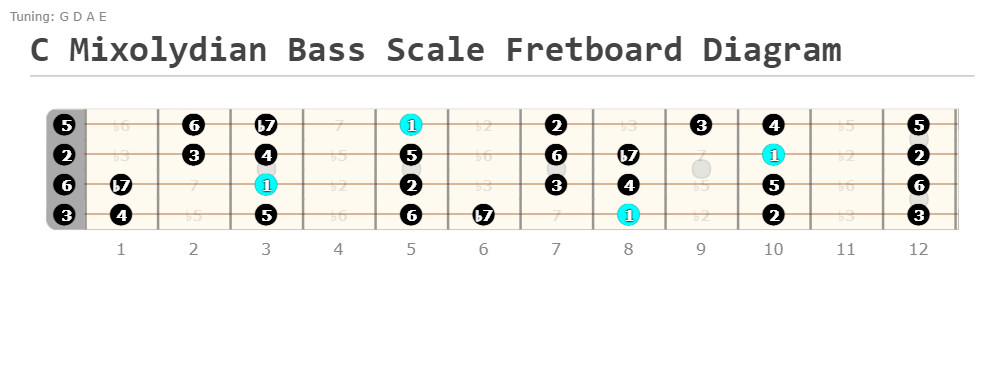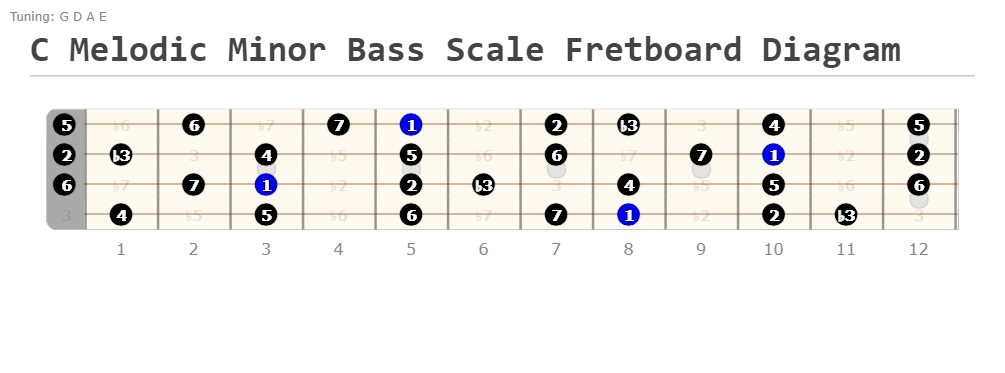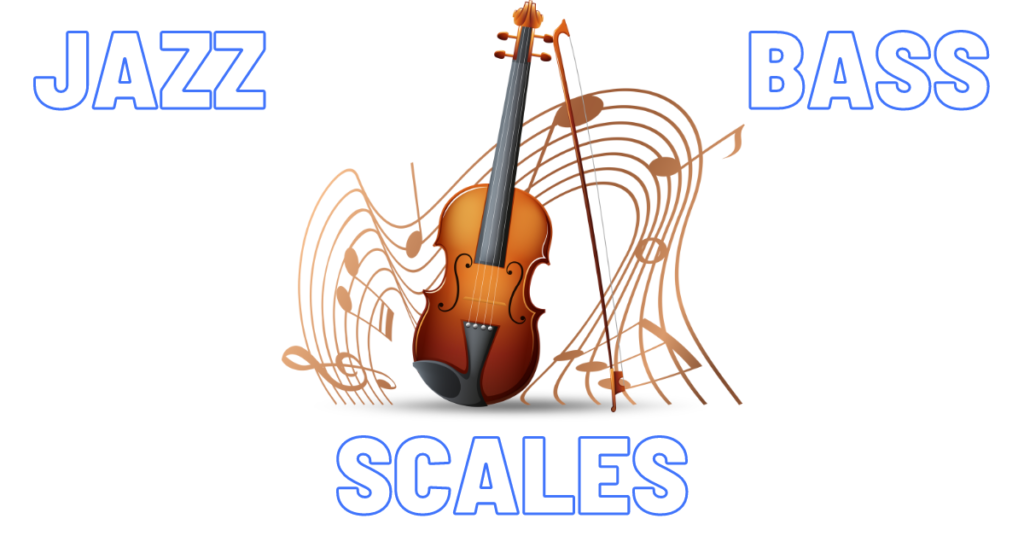Want to improve your improvisation skills and spice up your bass lines? Then you’re in the right place, my bass playing friend.
This article covers the best jazz bass scales, from the blues scale to the chromatic scale to major scale modes.
Memorizing these must-know jazz scales will give you a greater understanding of the fretboard, harmony’s relationship with scales, and jazz accompaniment.
Let’s dive in so you can discover the jazz bass scales every bassist needs to know!
Table of Contents
Dorian Mode
Formula: 1-2-b3-4-5-6-b7

The first scale that I like to teach is the Dorian scale/mode.
Dorian has the same harmonic structure as the natural minor scale/Aeolian mode, with the exception of its major 6th. This major 6th is what gives Dorian its signature sound!
The sound is used often in funk, and you can easily incorporate the major 6th interval in your minor pentatonic scale.
Due to its minor construction, the Dorian scale can be played over minor chords with the same name. This includes:
- Minor triads
- Minor 7th
- Minor 9th
- Minor 11th
- Minor 13th
So, if you want to add a funky, minor sound to your jazz bass lines, then you need to learn the Dorian mode.
Lydian Mode
Formula: 1-2-3-#4-5-6-7

Lydian is often called names like “exotic” and “haunting”, but you’ll just have to play it and listen to it to discover its sound.
You can think of Lydian as a major scale with a #4/b5. This creates a tritone relative to the root note, which gives Lydian that unique, tension-building sound that every musician loves.
It’s a major mode, and can be played over the following major chords:
- Major triads
- Major 7th
- Major 9th
- Major 13th
To get used to Lydian, simply play the #4 against any of the mentioned major chords during an accompaniment and improvisation practice session.
Like I mentioned earlier, that’s the single note that makes Lydian stand out from the major scale, so there’s no need to complicate the mode.
Here’s my Lydian Bass Scale Lesson, which goes in-depth on the mode, which will help you further understand what makes it one of the best jazz bass scales!
Mixolydian Mode
Formula: 1-2-3-4-5-6-b7

Mixolydian is another major mode.
Like Lydian, it also has a very similar construction to the major scale, but has a b7 rather than a major 7th.
This b7 interval alongside the major triad in Mixolydian’s diatonic construction makes a dominant 7th chord/arpeggio, which, as you probably guessed, makes the Mixolydian scale perfect for soloing and comping over dominant chords.
In chord progressions, this will shop up as the V7 chord.
Practice using Mixolydian over these chords:
- Major
- Dominant 7th
- Dominant 9th
- Dominant 13th
Remember, the target interval for Mixolydian is the b7. If you play the rest of its notes without applying the b7, then your bass line will sound like a typical Ionian (Major scale) bass line.
Fun tip: You can play a diminished arpeggio starting from the major third in a Mixolydian scale shape, which will imply all of its dominant tones and add some serious tension to your music. Using the Mixolydian fretboard diagram above, you’d play the 3rd, 5th, and b7 to pull this off.
Blues Scale
Formula: 1-b3-4-#4-5-b7

The blues scale? Yeah. It works quite well in jazz.
For starters, there’s a chromatic passing tone between the 4th and 5th, which is generally called the blues note, and chromatic passing tones are hot stuff in jazz. They give jazz the “jazz cats just play random notes” reputation, which is funny, and just makes me love the blues scale even more!
Aside from that, the blues scale doesn’t have any other tension-building tones, which makes it a great candidate for a setting where the harmony is simple.
Use it over minor chords with the same root note, and you’ll have a blast.
My blues scale bass lesson covers everything you need to know about the scale, so check it out!
Chromatic Scale

The chromatic scale, if you don’t know, is the scale that contains all 12 notes/intervals from Western harmony.
And how can you apply this as a jazz bass scale? Well, it’s actually quite similar to using a blues scale, but rather than having 1 chromatic passing tone, you have every chromatic passing tone available.
The secret is simple: Play a chromatic line, then land on an interval in the harmony. That’s it!
You’ll see chromatic passing tones used a lot in walking bass lines as well as improvisation, so it’s useful to know and understand it.
And yeah, it’s one of the most important jazz bass scales, but it’s also the fundamental scale for understanding harmony as a whole, and is used to construct every other scale in Western harmony.
Whole Tone
Formula: 1-2-3-b5-b6-b7

The whole tone scale is stupidly simple: Choose a root note, then move in whole-steps until you get to the octave! Hence the name, “whole tone scale”.
This makes it super easy to visualize across the entire fretboard, as you can see in the whole tone fretboard diagram.
And since it moves in whole steps, there are only two possible whole tone shapes.
I made everything blue in the diagram because you technically don’t need a set-in-stone root note to apply the whole tone scale, but that doesn’t mean you shouldn’t know where your root note is at all time!
Speaking of applying the scale, it’s somewhat similar to the chromatic scale, because it’s used primarily for tension-building sequences.
If you do play it relative to a root chord, it works well over dominant chords and altered chords.
Melodic Minor
Formula: 1-2-b3-4-5-6-7

Melodic minor is a little bit harder to grasp, and that’s why it’s the last of the jazz bass scales that I’ll have you learn.
It’s similar to Dorian, but has a major 7th rather than a b7 interval.
It’s also somewhat similar to the whole tone scale. This is easy to see if you look at the b3 on the B string, where you’ll notice 4 total whole steps before you reach the half-step leap to the root note.
Or you could think of it like a major scale with a b3…
No matter how you look at the melodic minor scale, though, you can come up with some mesmerizing bass lines.
Make sure you study the harmony closely to understand when to use this scale.
Prerequisites for learning jazz bass scales
The scales you learned here are popular for jazz due to their unique harmonic characteristics, but they’re useless if you don’t know common bass scales!
For starters, the 5 pentatonic shapes for bass are easy to learn, and useful for all genres of music due to their lack of tension-building harmony.
The C major bass scale is the next scale you should learn. The major scale is arguably the most important 7-note scale, and is used to understand harmony and construct modes.
Learning the minor scale on bass is the next step after learning the major scale. It’s the “sad” counterpart to the major scale, being built from the 6th degree of any major scale, and is certainly one of the most important jazz bass scales and scales as a whole.
Conclusion: Practicing jazz bass scales
To practice jazz bass scales you’ll want to figure out the one or two tones that make a particular scale unique, and practice targeting that tone!
Aside from that, you’ll want to analyze and compare the harmony of the scales. This will let you know when to use the scale.
Lastly, practice with backing tracks. Backing tracks always have the name of the key, and often show the chord names for the track as well!

